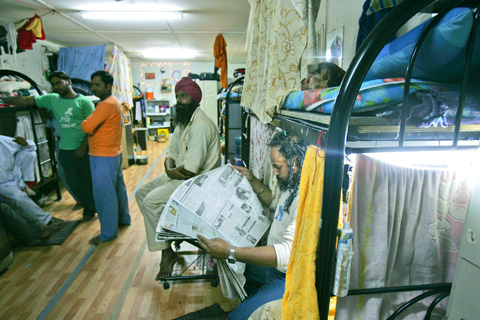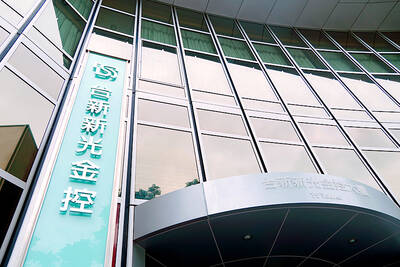The 22 men in “trailer 10” work the morning shift at a construction site, then take turns shopping, cooking and cleaning. They pray together. When one returns to India on leave, he carries family presents and cash for the others.
“We all come from the Punjab” in northern India, said Pavinder Singh, a 42-year-old carpenter from the trailer in a camp that houses about 3,000 workers on the desert outskirts of Dubai.
“But what makes us like a family is what we have to endure here together,” he said.

PHOTO: AP
The astonishing building boom in Dubai, which has made it one of the world’s fastest-growing cities, has been fueled by the labor of about 700,000 foreigners — almost all from poor, rural villages in India, Pakistan and Sri Lanka.
The workers’ meager wages still go far in their native lands. Two or three years in Dubai could mean building a house for their family, buying a plot of land or sending children to school. Yet many men escape poverty back home only to find themselves trapped in near servitude here.
Human rights groups have for years decried the harsh conditions of foreign laborers in Dubai, along with the rest of the United Arab Emirates (UAE) and the gulf. But the problem only drew widespread attention after strikes by thousands of workers this year and last.
Some recent protests turned violent — in mid-March, police arrested at least 500 South Asian workers who smashed office windows and set cars ablaze in neighboring Sharjah.
Dubai officials were embarrassed by the bad press. But despite promises of reform, there are still problems.
Many South Asian workers are essentially indentured servants, borrowing heavily to pay recruitment agents for jobs. They can spend several years paying back debts that can run US$3,000 or more with wages ranging from US$150 to US$300 a month. Lately, the laborers have earned less because of a weakened dollar — to which the Emirati dirham is tied — and Dubai’s double-digit inflation.
They work six days or even six and a half, and 60-hour weeks.
Employers often confiscate the workers’ passports, in violation of Dubai law, and withhold pay for two or three months to stop workers from quitting.
Many have no medical insurance and work outdoors in summer heat of 49˚C with stifling humidity.
Housing often means bare, crowded trailers surrounded by barbed wire or located on Dubai’s desert fringes. Some are not connected to water or sewage grids.
Overall, human rights groups say, unscrupulous employers and government indifference have combined to create one of the worst cases of systematic exploitation in today’s world.
Dubai and Emirati officials dismiss talk of a minimum wage as incompatible with Dubai’s market economy. But they insist they have taken steps to ensure regulations are followed at construction sites and living quarters.
“Our role is to make sure that what has been promised is what is actually paid,” said Alex Zalami, a senior adviser to the Emirates’ Labor Ministry. “The companies want to maximize profits. And what we do is teach them that productivity improves, if conditions improve for workers.”
He said a draft labor law soon to go before the Cabinet will allow the government to reject applications for importing workers from companies with a record of violations, force builders to improve conditions or face increased fines, and shut down repeat offenders.
Since January authorities have made firms put workers’ wages in bank accounts that can be monitored. Workers for major building companies have been given ATM cards to collect wages.
But Dubai officials acknowledge they still face several obstacles. One is persuading construction firms to make changes. Another is a shortage of labor inspectors — there are 400 now, almost twice as many as last year but well short of the target of 2,000.
It’s also difficult to build new camps with enough space and hygiene because of soaring land prices, officials say.
Workers can sue in court against employers who miss wages — but it seldom results in payment.
Belberdhas Devadassan said he was happy to be earning money to someday build a house back home. Yet the 23-year-old mason helping build Burj Dubai — already the world’s tallest building — lamented he was away from family in his best years.
“But I have to do this ... If I stay home, I will have no future,” he said. “I plan to be here for another six years and when I am done, I will have what I need.”

On Tuesday, US President Donald Trump weighed in on a pressing national issue: The rebranding of a restaurant chain. Last week, Cracker Barrel, a Tennessee company whose nationwide locations lean heavily on a cozy, old-timey aesthetic — “rocking chairs on the porch, a warm fire in the hearth, peg games on the table” — announced it was updating its logo. Uncle Herschel, the man who once appeared next to the letters with a barrel, was gone. It sparked ire on the right, with Donald Trump Jr leading a charge against the rebranding: “WTF is wrong with Cracker Barrel?!” Later, Trump Sr weighed

HEADWINDS: Upfront investment is unavoidable in the merger, but cost savings would materialize over time, TS Financial Holding Co president Welch Lin said TS Financial Holding Co (台新新光金控) said it would take about two years before the benefits of its merger with Shin Kong Financial Holding Co (新光金控) become evident, as the group prioritizes the consolidation of its major subsidiaries. “The group’s priority is to complete the consolidation of different subsidiaries,” Welch Lin (林維俊), president of the nation’s fourth-largest financial conglomerate by assets, told reporters during its first earnings briefing since the merger took effect on July 24. The asset management units are scheduled to merge in November, followed by life insurance in January next year and securities operations in April, Lin said. Banking integration,

LOOPHOLES: The move is to end a break that was aiding foreign producers without any similar benefit for US manufacturers, the US Department of Commerce said US President Donald Trump’s administration would make it harder for Samsung Electronics Co and SK Hynix Inc to ship critical equipment to their chipmaking operations in China, dealing a potential blow to the companies’ production in the world’s largest semiconductor market. The US Department of Commerce in a notice published on Friday said that it was revoking waivers for Samsung and SK Hynix to use US technologies in their Chinese operations. The companies had been operating in China under regulations that allow them to import chipmaking equipment without applying for a new license each time. The move would revise what is known

Artificial intelligence (AI) chip designer Cambricon Technologies Corp (寒武紀科技) plunged almost 9 percent after warning investors about a doubling in its share price over just a month, a record gain that helped fuel a US$1 trillion Chinese market rally. Cambricon triggered the selloff with a Thursday filing in which it dispelled talk about nonexistent products in the pipeline, reminded investors it labors under US sanctions, and stressed the difficulties of ascending the technology ladder. The Shanghai-listed company’s stock dived by the most since April in early yesterday trading, while the market stood largely unchanged. The litany of warnings underscores growing scrutiny of